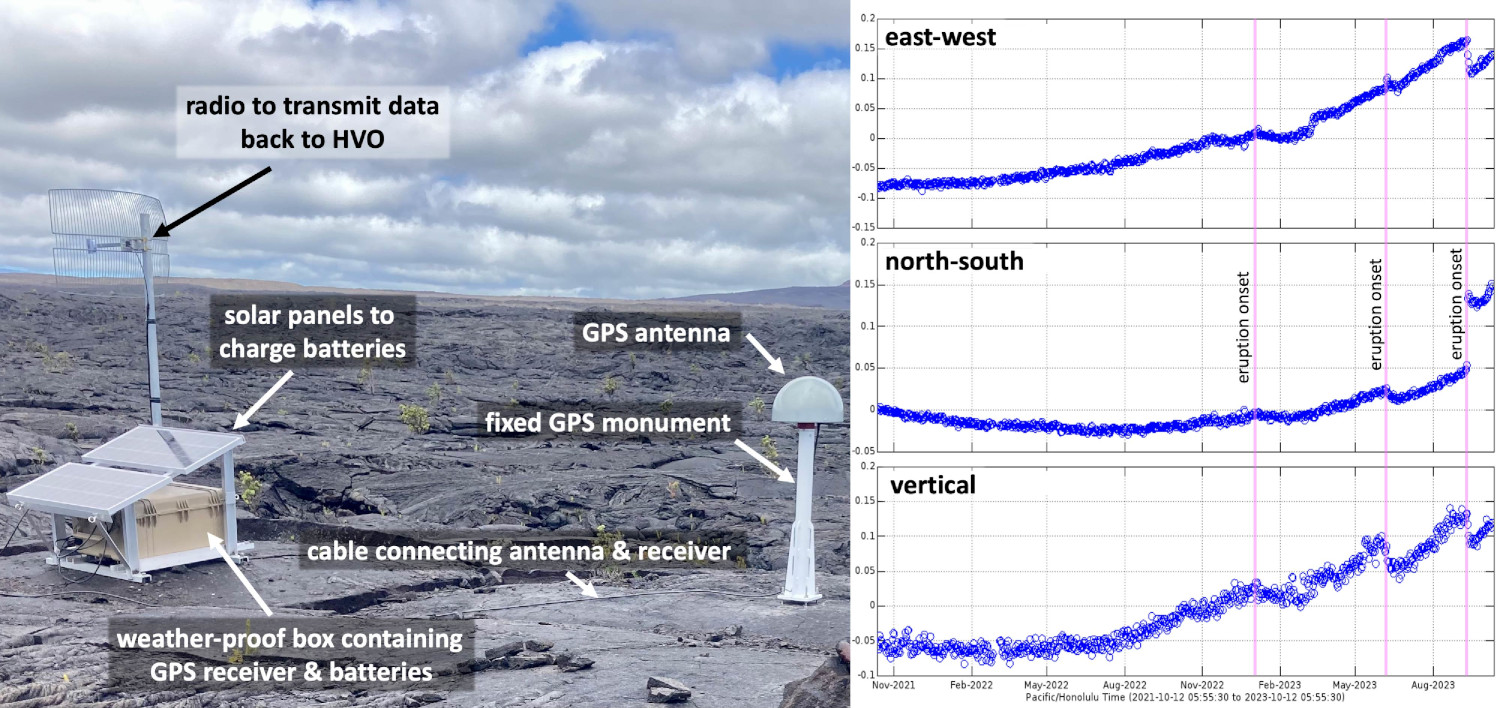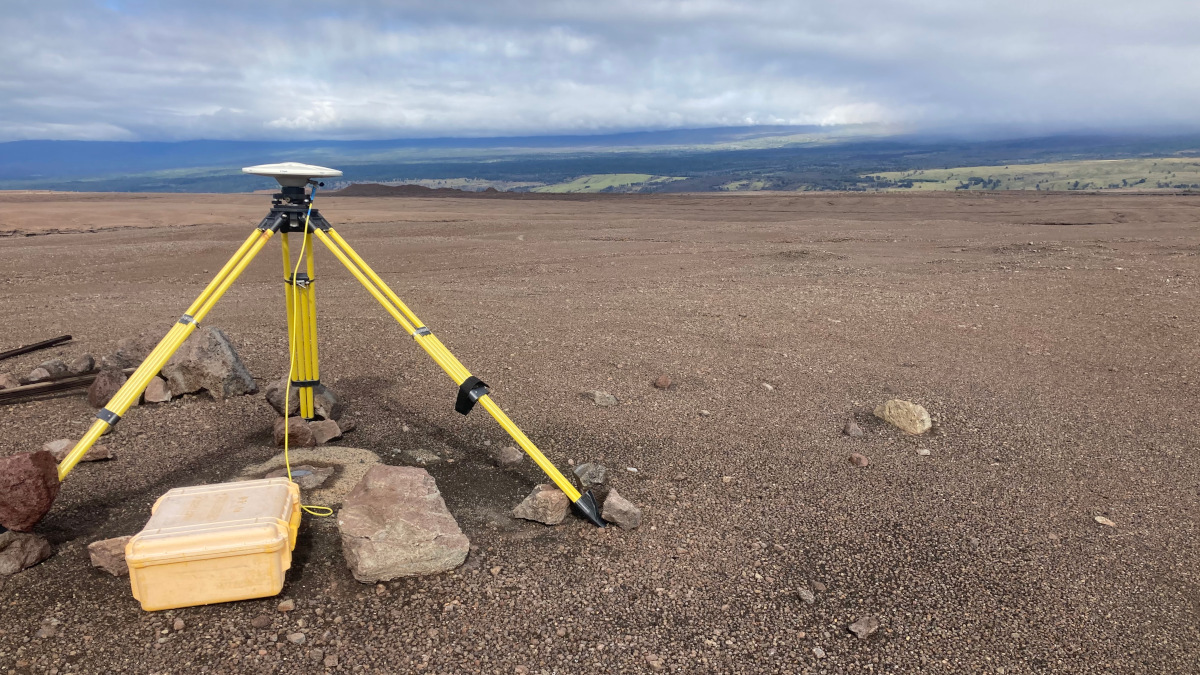
USGS: “Left: Annotated photo showing a continuous GPS monitoring station installed by HVO on the Island of Hawai’i. USGS photo by A.P. Ellis. Right: Example graph of processed daily GPS data positions in the east-west (top panel), north-south (middle panel), and vertical (bottom panel) axes for a GPS monitoring station at the summit of Kīlauea over the past two years. Vertical light red lines show onsets for the January 5, 2023, June 7, 2023, and September 10, 2023, Kīlauea summit eruptions. USGS plot.”
(BIVN) – Kīlauea is not erupting, and its USGS Volcano Alert level remains at ADVISORY.
The area just south of Kīlauea’s summit continues to show signs of episodic unrest. While inflation at the summit of Kīlauea remains high, there has been a “slight decrease in seismicity, in association with an intrusive event that began in early October,” scientists say.
Geologists are keeping a close eye on the tiltmeters at Uēkahuna and Sand Hill, looking for any changes.
“Overall, inflation at the summit of Kīlauea remains high and has surpassed the level seen just before the most recent eruption on September 10,” the U.S. Geological Survey Hawaiian Volcano Observatory wrote on Thursday. “However, the current rate of inflation in the region has diminished significantly since October 4-6 and more so over the last couple of days.”
From this week’s Volcano Watch article, written by USGS HVO scientists and affiliates:
For over thirty years, high-precision GPS (Global Positioning System) measurements have been a key tool used by the USGS Hawaiian Volcano Observatory (HVO). Scientists have come to depend on daily GPS positions to monitor changes in the shape of volcanoes and understand magma storage and movement underground.
GPS has also become an integral part of our daily lives, guiding us while driving and helping us find the nearest gas station or beach parking with remarkable precision: typically, 10–20 feet (3–6 meters), a miniscule distance on a global scale. However, scientists using GPS for volcano monitoring need to be able to measure changes that are less than a half of an inch (about a centimeter) to detect signs of magma moving underground—much more precise than a typical handheld GPS device or phone can offer.
So how do we get these very precise GPS measurements? Although the graphs of processed GPS data on HVO’s public website look like simple strings of “polka dots,” there is much more to the story. It is a complex process requiring high-precision equipment, advanced software, and powerful computing capabilities.
First, scientists and technicians install a specialized GPS antenna that is permanently fixed to the ground so that it measures only the motion of that specific spot. This GPS antenna is then connected to a high-precision, low noise GPS “receiver,” which carefully tracks the signals (electro-magnetic waves) that it receives from GPS satellites in space.
Specialized software uses the signals recorded by the receiver to determine a precise GPS position. It does this by calculating the distances between the GPS antenna and the orbiting satellites. Multiple simultaneous measurements are needed to calculate a site’s precise position in three-dimensions. For each dot on a daily GPS graph, a full 24 hours of data is used.
There is even more complexity to generate the most precise antenna locations. For example, scientists need to correct for some of the many factors that add uncertainty or noise to the primary GPS signal which further complicates the accuracy of GPS. This is where advanced software comes in.
Since the early 1990s, HVO scientists have been using GPS processing software from NASA’s Jet Propulsion Laboratory to get high-quality, precise GPS positions. The software first calculates travel times for signals from each GPS satellite to the antenna. It then uses details about the satellite clocks, orbit positions, and special geometry (called triangulation) to calculate a precise position of the GPS antenna. The combination of several sophisticated refinement techniques helps scientists calculate very precise positions with errors that are less than a half of an inch (centimeter scale).
This spring, HVO upgraded their GPS data processing software to the latest program suite. It is designed to be more precise, accurate, user-friendly, and flexible. HVO continues to be at the forefront of GPS data collection and processing to monitor the active volcanoes in Hawaii and American Samoa and to best understand their risks, while advancing scientific knowledge and hopefully reducing the negative impacts of volcanic eruptions.
HVO has over 70 permanent and continuously operating GPS stations on the Island of Hawai’i that gather data every day. Plus, HVO scientists collect survey measurements at another 50 to 70 benchmarks for a couple days a year. That’s a lot of raw data needing GPS post-processing to achieve the high-precision necessary for monitoring volcanoes!
At the end of October, HVO scientists just completed the annual Kīlauea GPS campaign survey, visiting approximately 20 sites across the volcano. HVO also conducts an annual GPS survey at Mauna Loa volcano and less frequent surveys at Hualālai and Haleakalā, every 5–10 years, as part of the volcano monitoring program.
The next time you are checking out one of HVO’s GPS graphs, now you’ll know a bit more about how much equipment, software, and analysis goes into each little dot.


by Big Island Video News7:41 am
on at
STORY SUMMARY
HAWAIʻI VOLCANOES NATIONAL PARK - Scientists say they depend on daily GPS positions to monitor changes in the shape of volcanoes and understand magma storage and movement underground.